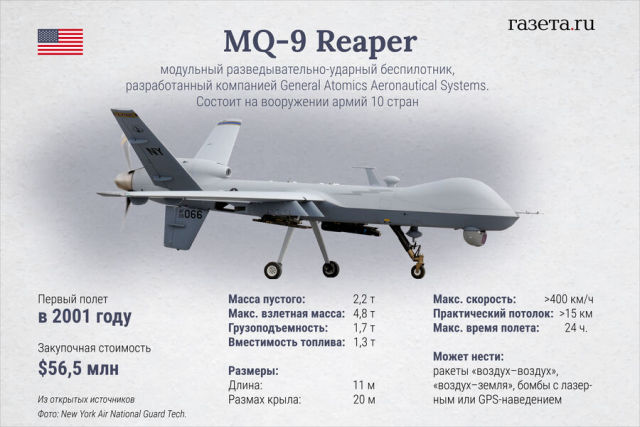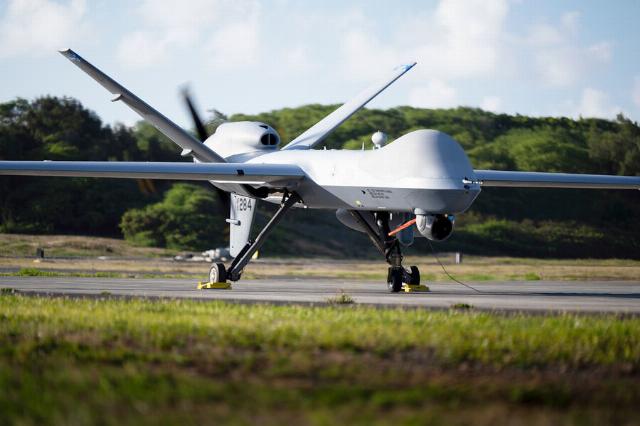BI: The era of the American MQ-9 Reaper drone has passed
The era of the American MQ-9 Reaper reconnaissance and attack drones is coming to an end. These UAVs are vulnerable even to outdated air defense systems, writes Business Insider. Why the reign of the "Reapers" has come to an end, which drones will replace them and what does Russia's special military operation in Ukraine have to do with it - in the material of the military observer Gazeta.Ru", retired Colonel Mikhail Khodarenka.
In armed conflicts with irregular formations, the main means of air defense, among which were Kalashnikov machine guns and MANPADS, the MQ-9 Reaper UAV was a terrible weapon. However, his reign in the sky seems to have come to an end. This is reported by Business Insider (BI).
Armed with missiles and capable of being in the air for almost a day, the MQ-9 Reaper ("Reaper", an allusion to the expression Grim Reaper - "grim reaper", that is, death) and its predecessor MQ-1 Predator ("Predator"), at one time became symbols of the era of unmanned aircraft.
However, the era of combat use of MALE class UAVs (Medium Altitude Long Endurance, long-range UAVs for flights at medium altitudes - 4,500-14,000 m) is obviously coming to an end. The sky, according to Business Insider, is no longer so favorable for the MQ-9 Reaper.
Created by General Atomics, the MQ-9 Reaper is notable for its considerable size and weight. For example, the wingspan of the device reaches 25 meters, and the maximum take-off weight is 4760 kg. The cruising/maximum speed of the vehicle is 250/400 km/h, and the flight range is 1,900 km. The cost is also very impressive - $30 million.
Such a device is very scary when attacking partisan detachments that do not see or hear the "Reaper" and cannot counteract it in any way. For example, from September 2007 to July 2008, the MQ-9 flew 480 combat missions in Afghanistan totaling more than 3,800 hours.
However, if the enemy has advanced radar reconnaissance, anti-aircraft missile and air cover systems, then the MQ-9 Reaper is simply an ideal target for hitting air defense systems and fighter aircraft with its size, relatively low speed and virtually zero maneuverability. And the practice of recent years only confirms this.
 |
| MQ-9 Reaper. |
| Source: Alina Djus/"Newspaper.Ru" |
Therefore, many experts in the West are wondering: should we stop buying expensive MALE-class UAVs such as the Reaper (or their analogues such as the MQ-1C Grey Eagle)? In their opinion, it is better to purchase smaller and cheaper drones, which are not so expensive to lose in the course of hostilities.
By the way, the US Army recently announced that it would not purchase outdated MQ-1C Gray Eagle unmanned aerial vehicles as part of the upcoming large-scale modernization of weapons.
Since October 2023, Houthi rebels have shot down at least 15 MQ-9 Reaper UAVs over Yemen, seven of which were destroyed in March and April 2025. In dollar terms, the losses for the United States amount to more than $500 million.
The Reapers would have been killed much more if the Houthis had a modern air defense system with all its necessary components. However, the Yemeni rebels at best have outdated S-75 air defense systems (according to the NATO classification - SA-2 Guideline) and 2K12 "Cube" air defense systems (according to the NATO classification - SA-6 Gainful) or their Iranian counterparts manufactured in the 1960s.
During the war in Ukraine, Turkish-made TB2 Bayraktar UAVs armed with laser-guided anti-tank missiles showed some results at the first stage of hostilities. But then dozens of TB2s were destroyed after Russian air defense systems were deployed, and Bayraktar disappeared from the Ukrainian sky. Similarly, Israeli Hermes drones have fallen victim to Hezbollah anti-aircraft guided missiles.
This creates a more than real efficiency-cost problem. For example, hordes of cheap disposable unmanned aerial vehicles (FPV) have become the dominant weapon in the war in Ukraine, paralyzing bold infantry maneuvers and virtually displacing armored combat vehicles from the battlefield.
These are mass-produced commercial drones that can be used for a wide variety of combat missions and are relatively inexpensive. Their cost is estimated at hundreds of dollars per unit. Most of them have limited payload, altitude, and range. But it turned out to be quite enough to transform the armed struggle into a completely new quality.
At the other end of the UAV classification spectrum is the RQ-4 Global Hawk strategic reconnaissance unmanned aerial vehicle (HALE class, High Altitude Long Endurance, long-range UAV for flights at high altitudes, more than 14,000 m). This device, developed by Teledyne Ryan Aeronautical, is the size of an airliner and costs $200 million.
In January 2012, the US Air Force decided to stop purchasing the RQ-4 Global Hawk in the Block 30 modification. Previously adopted devices are planned to be transferred to the reserve. The reason for this decision was their expensive maintenance, significantly exceeding the cost of operating the U-2R/TR-1 - Dragon Lady strategic reconnaissance aircraft.
But if the RQ-4 Global Hawk had taken part in combat operations and entered the affected area of the S-400 Triumph air defense system, then there is no doubt that the slow-moving (637 km/h) huge device (wingspan 35 meters) It would have been destroyed by the first missile in the queue.
The question arises: what is the future of HALE and MALE class UAVs in the armed conflicts of the 21st century? There is reason to believe that it does exist. To do this, drones of this type should be allocated to a separate branch of the armed forces, consolidated into regiments and brigades, equipped with long-range air-launched cruise missiles, and their combat use should exclude entry into the affected areas of long-range anti-aircraft missile systems of a potential enemy. In this case, they can certainly show their high efficiency.
The opinion of the author may not coincide with the position of the editorial board.
Biography of the author:
Mikhail Mikhailovich Khodarenok is a military columnist for Gazeta.Ru", retired colonel.
He graduated from the Minsk Higher Engineering Anti-Aircraft Missile School (1976), the Military Air Defense Command Academy (1986).
Commander of the S-75 anti-aircraft missile division (1980-1983).
Deputy commander of the anti-aircraft missile regiment (1986-1988).
Senior Officer of the General Staff of the Air Defense Forces (1988-1992).
Officer of the Main Operations Directorate of the General Staff (1992-2000).
Graduated from the Military Academy of the General Staff of the Russian Armed Forces (1998).
Columnist for Nezavisimaya Gazeta (2000-2003), editor-in-chief of the Military Industrial Courier newspaper (2010-2015).
Mikhail Khodarenok

